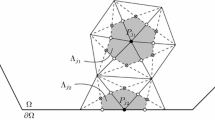Abstract
We consider finite element approximations of a second order elliptic problem on a bounded polytopic domain in ℝd with d ∈ {1, 2, 3, ...} The constant C ⩾ 1 appearing in Céa’s lemma and coming from its standard proof can be very large when the coefficients of an elliptic operator attain considerably different values. We restrict ourselves to regular families of uniform partitions and linear simplicial elements. Using a lower bound of the interpolation error and the supercloseness between the finite element solution and the Lagrange interpolant of the exact solution, we show that the ratio between discretization and interpolation errors is equal to \(1 + \mathcal{O}(h)\) as the discretization parameter h tends to zero. Numerical results in one and two-dimensional case illustrating this phenomenon are presented.
Similar content being viewed by others
References
I. Babuška, A. K. Aziz: Survey lectures on the mathematical foundations of the finite element method. Math. Found. Finite Elem. Method Appl. Part. Differ. Equations (A. K. Aziz, ed.). Academic Press, New York, 1972, pp. 1–359.
I. Babuška, T. Strouboulis, C. S. Upadhyay, and S. K. Gangaray: Computer-based proof of the existence of superconvergence points in the finite element method; superconvergence of the derivatives in the finite element solutions of Laplace’s, Poisson’s, and elasticity equations. Numer. Methods Partial Differ. Equations 12 (1996), 347–392.
J. Brandts, M. Křížek: Gradient superconvergence on uniform simplicial partitions of polytopes. IMA J. Numer. Anal. 23 (2003), 489–505.
J. Brandts, M. Křížek: Superconvergence of tetrahedral quadratic finite elements. J. Comput. Math. 23 (2005), 27–36.
J. Céa: Approximation variationnelle des problèmes aux limites. Ann. Inst. Fourier 14 (1964), 345–444.
P. Clément: Approximation by finite element functions using local regularization. RAIRO Anal. Numér. 9 (1975), 77–84.
C. M. Chen: Optimal points of stresses for tetrahedron linear element. Natur. Sci. J. Xiangtan Univ. 3 (1980), 16–24. (In Chinese.)
L. Chen: Superconvergence of tetrahedral linear finite elements. Internat. J. Numer. Anal. Model. 3 (2006), 273–282.
P. G. Ciarlet: The Finite Element Method for Elliptic Problems. North-Holland, Amsterdam, 1978.
G. Goodsell, J. R. Whiteman: Pointwise superconvergence of recovered gradients for piecewise linear finite element approximations to problems of planar linear elasticity. Numer. Methods Partial Differ. Equations 6 (1990), 59–74.
I. Hlaváček, M. KříŽek: On a superconvergent finite element scheme for elliptic systems. I. Dirichlet boundary condition. Apl. Mat. 32 (1987), 131–154.
V. Kantchev, R. Lazarov: Superconvergence of the gradient of linear finite elements for 3D Poisson equation. In: Proc. Int. Symp. Optimal Algorithms (B. Sendov, ed.). Bulgarian Acad. Sci., Sofia, 1986, pp. 172–182.
M. Křéžek, P. Neittaanmäki: On superconvergence techniques. Acta Appl. Math. 9 (1987), 175–198.
M. Křížek, P. Neittaanmäki: Finite Element Approximation of Variational Problems and Applications. Pitman Monographs and Surveys in Pure and Applied Mathematics Vol. 50. Longman Scientific & Technical, Harlow, 1990.
M. Křížek, P. Neittaanmäki: Mathematical and Numerical Modelling in Electrical Engineering: Theory and Applications. Kluwer Academic Publishers, Dordrecht, 1996.
H.W. Kuhn: Some combinatorial lemmas in topology. IBM J. Res. Develop. 4 (1960), 518–524.
B. Li: Lagrange interpolation and finite element superconvergence. Numer. Methods Partial Differ. Equations 20 (2004), 33–59.
Q. Lin, N. N. Yan: The Construction and Analysis for Efficient Finite Elements. Hebei Univ. Publ. House, 1996. (In Chinese.)
L. A. Oganesjan, L. A. Ruhovec: An investigation of the rate of convergence of variational-difference schemes for second order elliptic equations in a two-dimensional region with smooth boundary. Ž. Vyč isl. Mat. i Mat. Fiz. 9 (1969), 1102–1120. (In Russian.)
P. Tong: Exact solutions of certain problems by finite-element method. AIAA J. 7 (1969), 178–180.
L. B. Wahlbin: Superconvergence in Galerkin Finite Element Methods. Lecture Notes in Math. Vol. 1605. Springer-Verlag, Berlin, 1995.
J. Xu, L. Zikatanov: Some observations on Babuška and Brezzi theories. Numer. Math. 94 (2003), 195–202.
Q. D. Zhu: The derivative good points for the finite element method with 2-degree triangular element. Nat. Sci. J. Xiangtan Univ. 1 (1981), 36–44. (In Chinese.)
Author information
Authors and Affiliations
Additional information
This research was supported by Shandong Province Young Scientists Foundation of China 2005BS01008, Institutional Research Plan AV02 101 90503, and by Grant No A 1019201 of the Academy of Sciences of the Czech Republic.
Rights and permissions
About this article
Cite this article
Chen, W., Křížek, M. What is the smallest possible constant in Céa’s lemma?. Appl Math 51, 129–144 (2006). https://doi.org/10.1007/s10492-006-0009-7
Received:
Issue Date:
DOI: https://doi.org/10.1007/s10492-006-0009-7



